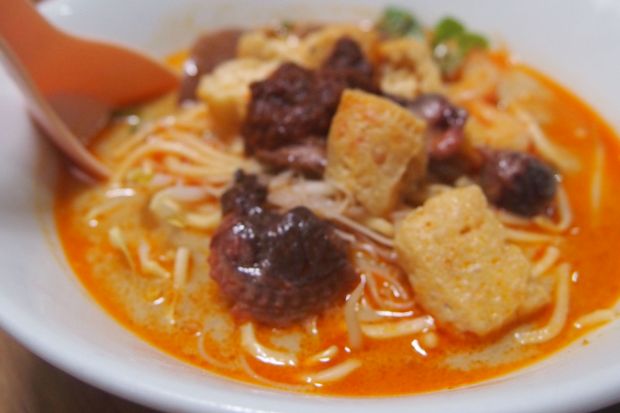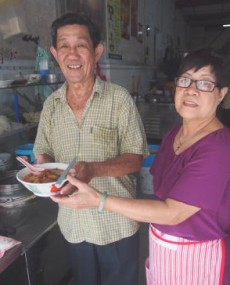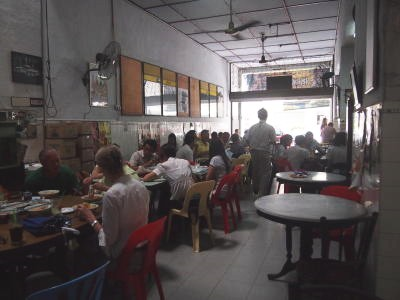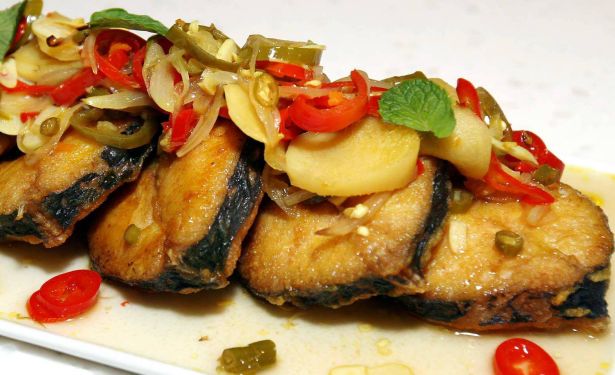We should take advantage of the expertise of old-time hawkers to make Penang even more famous as a food hub.
HOKKIEN mee seller Loo Chin Wah, 72, has been much featured in local and national press recently. After over 50 years, Ah Wah, as he is affectionately known, dished up the last bowl of his famous prawn-stock noodles on Aug 24, thus bringing to a close yet another iconic stall selling popular Penang favourites.
Starting as an itinerant hawker in the late 1950s with a stall which he would push all over the Majestic Cinema area near Penang Road – “I remember seeing Rose Chan (famous striptease) perform in those days!” he recalled – Ah Wah ended up parking himself at the front of the Hwa Pin Kopitiam in Church Street a couple of years later. And from there, aided by faithful wife Ong Phaik Keow, 68, he continued to dispense his noodles until last month.
Lawyer Cecil Rajendra, who has been eating at Hwa Pin for the past two or three decades, took it upon himself to organise the “Last Hurrah for Ah Hua’s (sic) Hokkien Mee”, sending out press releases to the various dailies, thus ensuring that Ah Wah got a fitting send-off.
Long-time customers and old friends, particularly those who have worked in the vicinity for decades came to bid adieu and to savour, for one last time, his Hokkien mee and equally popular curry mee. Even Penang’s chief minister Lim Guan Eng stopped by for a bowl.
Tourists and expats, too, gathered at the coffee shop on the day, including Heida Haye from The Netherlands, who used to live in Penang in the 1970s.
“I used to eat here then, too!” she laughed.
Loo’s son, Ah Kean, 41, was there to mark the occasion.
“All my childhood I remember coming here,” he reminisced. “I used to have my naps on the table which used to stand there!” he said, gesturing to the spot next to his father’s stall.
In those days, a small bowl cost just 20 sen (30 sen for the large one) compared to RM3 to RM3.50 now.
“Prices of ingredients have escalated tremendously,” Ah Wah bemoaned, “especially prawns and pork.” This, he felt, has contributed to a downturn in business for them, one reason he decided to call it a day.
Another reason is ill health. “I am not young anymore,” he said simply. “The work is getting too much.”
Sadly, Ah Wah’s stall may remain vacant for the foreseeable future as he has yet to find someone to take over. Unlike some of our well-known stalls which are now manned by the second-, third- or even fourth-generation descendants, his children show no interest in continuing the family business. In fact, three of them live in New York, where the Loos plan to visit soon.
“I work in a factory at the moment,” when I asked Ah Kean if he was going to take over from his parents. “Who knows? Maybe one day I will.”
This is one problem which Penang’s hawkers face. A traditional fallback for those who have come on hard times as it requires minimal start-up capital, a hawker stall can, once established, generate steady income to enable them to provide better futures and education for their children. However, this in turn means that their offspring may neither have the need nor desire to continue the family tradition.
Despite training several apprentices, Ah Wah has not been able to retain them; it is hard work, after all.
“We have to be up at 4am every day,” he said. Preparing the all-important stock is tedious work. Made with pork bones and fresh prawns which require not just long simmering – the shells also need to be blended, then sieved so the sweet essence is extracted – it takes hours to prepare.
With Unesco heritage status, Penang has been attracting more and more visitors, many of whom want to try our famous local food. We should capitalise on our unique selling point: our traditional street food. Instead of seeing it as a last resort, our young chefs should be encouraged to take it up as a profession, serving it in their outlets as one of Penang’s true-blue cuisines.
Hawker food no longer has to be cheap and cheerful, the poor cousin of more expensive Western fare which has proliferated here in recent years. It can be served in hygienic, pleasant air-conditioned surroundings and not just roadside stalls or ancient kopitiams. This new, higher-earning generation is prepared to pay more so it can be reasonably priced, thus ensuring good returns.
It would be a shrewd move for the State Government to establish culinary centres in collaboration with our chefs’ associations and old-timers or retired hawkers like Ah Wah, where they can pass on their expertise to those who are prepared to learn, whether they are chefs, tourists or housewives.
To further encourage such ventures, they could even consider giving grants or loans to those who set up outlets selling hawker food, thus ensuring that the skills and the individual secret recipes don’t die out.
As an aside, it would also have the added benefit that we don’t over-venerate those we have, as this has been known to backfire, resulting in poor service and an arrogant attitude.
However, to humble people like Ah Wah who, despite the number of press people, cameramen and hungry patrons who descended on him on his day of business, remained friendly and courteous, I say, “Thank you for the years of serving good food.”
“I’ve been coming here for nearly 40 years,” said lawyer David Khaw, who has an office around the corner in Bishop Street.
“Ah Wah is a real living heritage of Penang. We should acknowledge people like him who have been feeding us for years.” This is Helen Ong’s final Eats column. She will continue to write occasionally for Star2.







